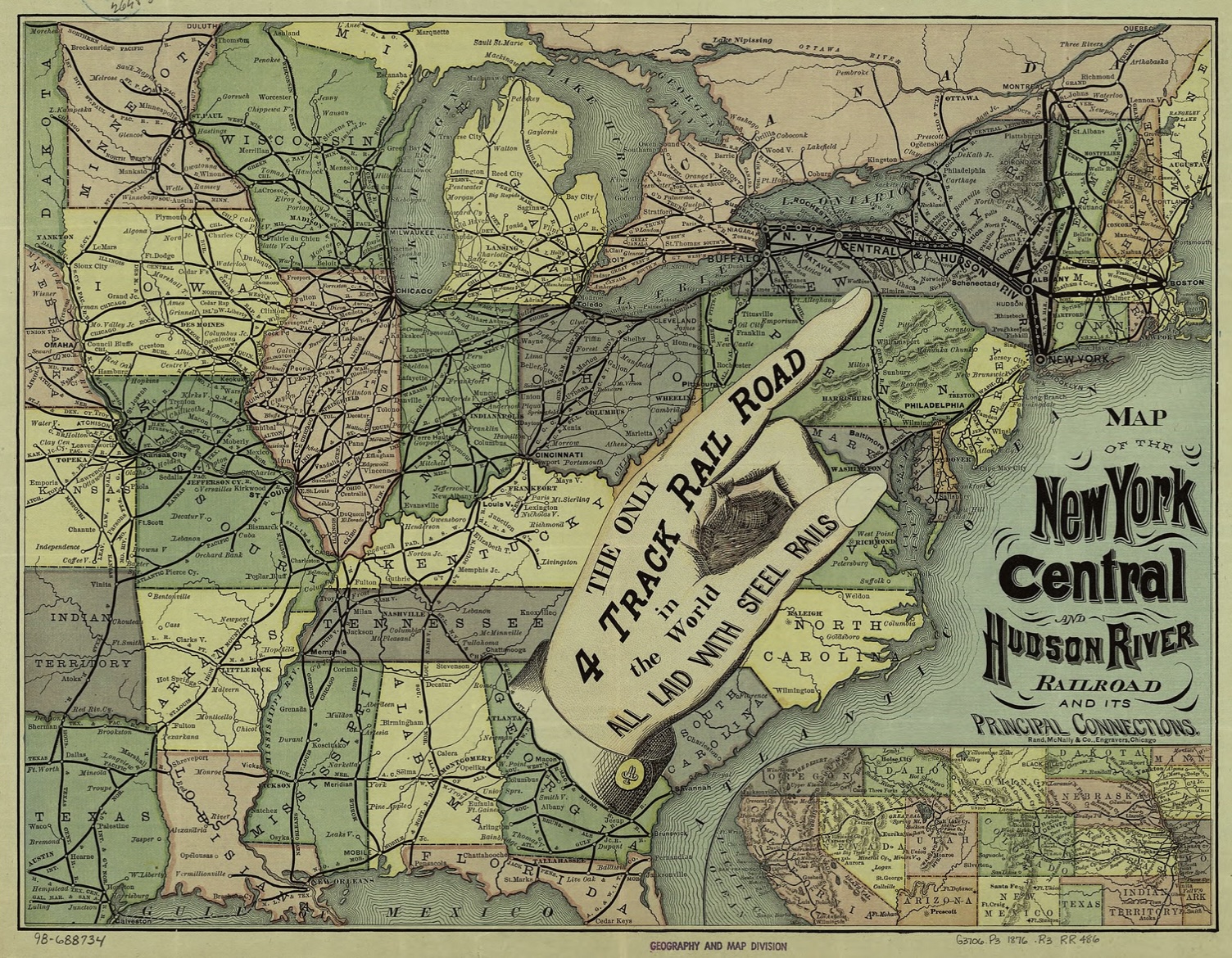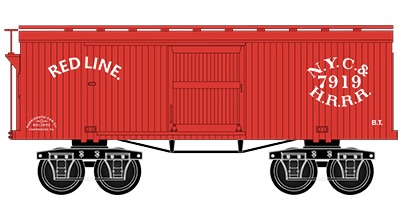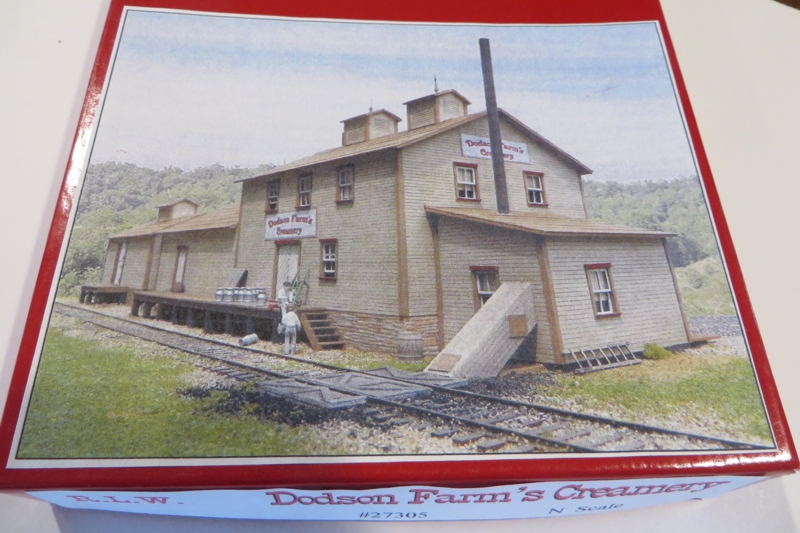Specific Item Information: 3 each 26’ Civil War Era Box Cars, 1 each 26’ Civil War Era Flat Car, Road Numbers: 7919, 8052, D16689, 15019
Road Name History:  In 1867, Cornelius Vanderbilt acquired control of the Albany to Buffalo-running NYC, with the help of maneuverings related to the Hudson River Bridge in Albany. On November 1, 1869, he merged the NYC with his Hudson River Railroad to form the New York Central and Hudson River Railroad. This extended the system south from Albany along the east bank of the Hudson River to New York City, with the leased Troy and Greenbush Railroad running from Albany north to Troy.
In 1867, Cornelius Vanderbilt acquired control of the Albany to Buffalo-running NYC, with the help of maneuverings related to the Hudson River Bridge in Albany. On November 1, 1869, he merged the NYC with his Hudson River Railroad to form the New York Central and Hudson River Railroad. This extended the system south from Albany along the east bank of the Hudson River to New York City, with the leased Troy and Greenbush Railroad running from Albany north to Troy.
Vanderbilt's other lines were operated as part of the NYC; these included the New York and Harlem Railroad, Lake Shore and Michigan Southern Railway, Canada Southern Railway and Michigan Central Railroad.
The Spuyten Duyvil and Port Morris Railroad was chartered in 1869 and opened in 1871, providing a route on the north side of the Harlem River for trains along the Hudson River to head southeast to the New York and Harlem Railroad. Trains could head toward Grand Central Depot, built by NYC and opened in 1871, or to the freight facilities at Port Morris. From opening, it was leased by the NYC.
The Geneva and Lyons Railroad was organized in 1877 and opened in 1878, leased by the NYC from opening. This was a connection between Syracuse and Rochester, running from the main line at Lyons to the Auburn Road at Geneva. It was merged into the NYC in 1890.
In 1885, the New York, West Shore and Buffalo Railway, a competitor since 1883 with trackage along the west shore of the Hudson River and on to Buffalo closely paralleling the NYC, was taken over by the NYC as the West Shore Railroad and developed passenger, freight, and car float operations at Weehawken Terminal. The NYC assumed control of the Pittsburgh and Lake Erie and Boston and Albany Railroads in 1887 and 1900, respectively, with both roads remaining as independently-operating subsidiaries. William H. Newman, president of the New York Central lines, resigned in 1909. Newman had been president since 1901, when he replaced Samuel R. Callaway (who had replaced Depew as president in 1898).
In 1914, the operations of eleven subsidiaries were merged with the New York Central & Hudson River Railroad, re-forming the New York Central Railroad. From the beginning of the merger, the railroad was publicly referred to as the New York Central Lines. In the summer of 1935, the identification was changed to the New York Central System, that name being kept until the merger with the Pennsylvania Railroad in 1968..From Wikipedia

Vanderbilt's other lines were operated as part of the NYC; these included the New York and Harlem Railroad, Lake Shore and Michigan Southern Railway, Canada Southern Railway and Michigan Central Railroad.
The Spuyten Duyvil and Port Morris Railroad was chartered in 1869 and opened in 1871, providing a route on the north side of the Harlem River for trains along the Hudson River to head southeast to the New York and Harlem Railroad. Trains could head toward Grand Central Depot, built by NYC and opened in 1871, or to the freight facilities at Port Morris. From opening, it was leased by the NYC.
The Geneva and Lyons Railroad was organized in 1877 and opened in 1878, leased by the NYC from opening. This was a connection between Syracuse and Rochester, running from the main line at Lyons to the Auburn Road at Geneva. It was merged into the NYC in 1890.
In 1885, the New York, West Shore and Buffalo Railway, a competitor since 1883 with trackage along the west shore of the Hudson River and on to Buffalo closely paralleling the NYC, was taken over by the NYC as the West Shore Railroad and developed passenger, freight, and car float operations at Weehawken Terminal. The NYC assumed control of the Pittsburgh and Lake Erie and Boston and Albany Railroads in 1887 and 1900, respectively, with both roads remaining as independently-operating subsidiaries. William H. Newman, president of the New York Central lines, resigned in 1909. Newman had been president since 1901, when he replaced Samuel R. Callaway (who had replaced Depew as president in 1898).
In 1914, the operations of eleven subsidiaries were merged with the New York Central & Hudson River Railroad, re-forming the New York Central Railroad. From the beginning of the merger, the railroad was publicly referred to as the New York Central Lines. In the summer of 1935, the identification was changed to the New York Central System, that name being kept until the merger with the Pennsylvania Railroad in 1968..From Wikipedia
Brand/Importer Information: Micro-Trains is the brand name used by both Kadee Quality Products and Micro-Trains Line. For a history of the relationship between the brand and the two companies, please consult our Micro-Trains Collector's Guide.
Manufacturer Information:  Micro-Trains Line split off from Kadee Quality Products in 1990. Kadee Quality Products originally got involved in N-Scale by producing a scaled-down version of their successful HO Magne-Matic knuckle coupler system. This coupler was superior to the ubiquitous 'Rapido' style coupler due to two primary factors: superior realistic appearance and the ability to automatically uncouple when stopped over a magnet embedded in a section of track. The success of these couplers in N-Scale quickly translated to the production of trucks, wheels and in 1972 a release of ready-to-run box cars.
Micro-Trains Line split off from Kadee Quality Products in 1990. Kadee Quality Products originally got involved in N-Scale by producing a scaled-down version of their successful HO Magne-Matic knuckle coupler system. This coupler was superior to the ubiquitous 'Rapido' style coupler due to two primary factors: superior realistic appearance and the ability to automatically uncouple when stopped over a magnet embedded in a section of track. The success of these couplers in N-Scale quickly translated to the production of trucks, wheels and in 1972 a release of ready-to-run box cars.
Micro-Trains Line Co. split off from Kadee in 1990 to form a completely independent company. For this reason, products from this company can appear with labels from both enterprises. Due to the nature of production idiosyncrasies and various random factors, the rolling stock from Micro-Trains can have all sorts of interesting variations in both their packaging as well as the products themselves. When acquiring an MTL product it is very important to understand these important production variations that can greatly enhance (or decrease) the value of your purchase.
Please consult our Micro-Trains Collector's Guide

Micro-Trains Line Co. split off from Kadee in 1990 to form a completely independent company. For this reason, products from this company can appear with labels from both enterprises. Due to the nature of production idiosyncrasies and various random factors, the rolling stock from Micro-Trains can have all sorts of interesting variations in both their packaging as well as the products themselves. When acquiring an MTL product it is very important to understand these important production variations that can greatly enhance (or decrease) the value of your purchase.
Please consult our Micro-Trains Collector's Guide
Item created by: CNW400 on 2022-02-25 12:22:47. Last edited by George on 2024-01-26 20:29:17
If you see errors or missing data in this entry, please feel free to log in and edit it. Anyone with a Gmail account can log in instantly.
If you see errors or missing data in this entry, please feel free to log in and edit it. Anyone with a Gmail account can log in instantly.







